Have you been suffering from persistent shoulder pain that limits your daily activities and affects your quality of life? If so, you may be experiencing the debilitating effects of a rotator cuff injury. The rotator cuff, a group of muscles and tendons that surround the shoulder joint, plays a crucial role in its stability and movement. When damaged, it can lead to pain, weakness, and a restricted range of motion. Fear not, because at the Sydney Orthopaedic Surgeon Clinic, we specialise in diagnosing and treating rotator cuff injuries, led by Dr Stuart Kirkham.
With over 25 years of experience, Dr Kirkham is a highly skilled orthopaedic surgeon who has dedicated his expertise to helping patients overcome a range of injuries, including the challenges associated with rotator cuff injuries. From mild discomfort to severe pain and functional limitations, he understands the wide spectrum of symptoms that can arise. Dr Kirkham and our compassionate team are here to provide you with effective and personalised care, tailoring treatment plans to your unique needs and goals.
Whether you’re grappling with nagging shoulder pain, struggling with daily activities, or dealing with severe discomfort, the Sydney Orthopaedic Surgeon Clinic is here to provide the specialised care you need for your rotator cuff injury. Reach out to Dr Kirkham today for a consultation and a tailored treatment plan that suits your specific circumstances. Together, let’s restore your shoulder function and get you back to enjoying the activities you cherish.
Anatomy of The Rotator Cuff
The shoulder joint is a remarkable structure that allows for a wide range of motion, but its complexity can sometimes lead to vulnerabilities, such as rotator cuff tears. To truly understand the impact of these injuries, let’s take a closer look at the anatomy of the shoulder and the crucial role played by the rotator cuff.
The shoulder consists of three main bones: the humerus (the upper arm bone), the scapula (your shoulder blade), and the clavicle (or collarbone). It is a ball-and-socket joint, where the rounded head of the humerus fits into the shallow socket of the scapula, known as the glenoid. This anatomy grants the shoulder its unparalleled mobility.
The rotator cuff itself is a group of four muscles and their tendons that envelop and stabilise the shoulder joint. These muscles include the supraspinatus, infraspinatus, teres minor, and subscapularis. Individually, they have their own specific functions, but collectively, they work in harmony to keep the humerus centred within the glenoid, allowing for smooth and controlled movement.
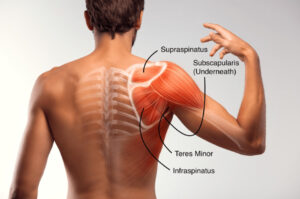
The rotator cuff plays a vital role in the functionality of the shoulder joint. It not only provides stability but also facilitates a wide range of motions, including lifting, reaching, and rotating the arm. It acts as a dynamic stabiliser, especially during overhead activities, ensuring that the shoulder joint remains centred and secure.
Without a healthy and intact rotator cuff, the shoulder’s stability and mobility are compromised. Rotator cuff injuries, such as tears or strains, can significantly impact an individual’s daily life and limit their physical activity. Simple tasks like lifting objects or reaching for items overhead become challenging and painful. Understanding the importance of the rotator cuff only emphasis the significance of prompt and effective treatment for any injuries or issues affecting this crucial structure.
Causes and Risk Factors of Rotator Cuff Injuries
Rotator cuff tendons can tear as one or as a group. The most common tears are of the supraspinatus and subscapularis. Two distinctive age groups typically experience these injuries, and they tend to fit into two different patient profiles.
The first group typically consists of younger patients aged 35-45 that have experienced trauma or an injury that causes the tendon to suddenly tear. This is known as an acute tear, and it often occurs in conjunction with other injuries such as a broken collarbone or dislocated shoulder.
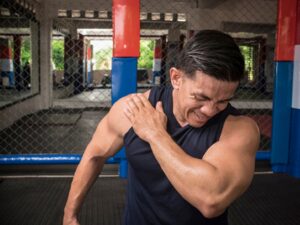
However, the older patient profile, which tends to experience the injury much more commonly, is aged approximately 50-90. They usually experience a slower, more insidious onset of a tendon failure, and this is known as a degenerative tear. This often occurs without any specific injury or trauma to the area and simply occurs as the tendon tissue degrades, or degenerates, with every decade of life.
However, there are some other factors that predispose individuals to rotator cuff injuries.
Repetitive Overuse
Over time, repetitive motions and activities that strain the shoulder can contribute to rotator cuff injuries. Occupations or hobbies that involve repetitive overhead movements, such as painting, construction work, or throwing sports, can gradually wear down the rotator cuff tendons, leading to tears.
Poor Posture and Muscle Imbalances
Maintaining poor posture or having muscle imbalances in the shoulder girdle can place excessive stress on the rotator cuff tendons. This can lead to impingement syndrome, where the tendons become pinched or compressed between the bones, resulting in inflammation and injury.
Genetics
Some individuals may have a genetic predisposition to developing rotator cuff injuries. Structural abnormalities or inherited traits can make the tendons more vulnerable to degeneration or tears.
Smoking and Poor Nutrition
Unhealthy lifestyle choices, such as smoking and a diet lacking in essential nutrients, can impair the body’s natural ability to repair and maintain healthy tissues. This can increase the risk of rotator cuff injuries and hinder the healing process.
Shoulder Impingement Syndrome
Rotator cuff tendinitis, or shoulder impingement syndrome, can also weigh heavily on the health of your rotator cuff. This condition often occurs as a result of overuse of the shoulder joint, and it creates swelling of the tissues that connect the muscles and bones of the shoulder. This can result in a dull ache or stiffness of the shoulder joint, and while simply resting and icing the area can be an effective remedy, shoulder impingement syndrome can gradually develop and worsen to cause a rotator cuff tear if it is not given effective care.
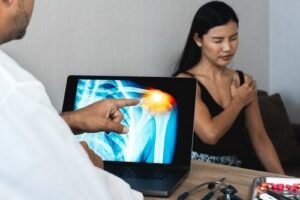
Regardless of the cause of a rotator cuff injury, Dr Kirkham at the Sydney Orthopaedic Surgeon Clinic can offer specialist experience to treat and diagnose any form of rotator cuff injuries. His expertise allows him to accurately identify the condition before symptoms worsen, enabling early intervention to prevent further damage. By addressing the underlying causes and risk factors, Dr Kirkham provides individualised guidance and recommendations to help patients avoid inhibiting symptoms that may significantly impact their daily lives.
Symptoms and Identification of Rotator Cuff Injuries
Rotator cuff injuries can manifest through a number of different symptoms, and recognising them is essential for early identification and timely treatment. The most common symptoms associated with rotator cuff injuries include persistent shoulder pain, weakness, limited range of motion, and difficulty performing everyday activities.
Shoulder pain is a hallmark symptom of rotator cuff injuries and can range from a dull ache to sharp, intense pain. The pain is often felt deep within the shoulder and may radiate down the arm. It can be aggravated by specific movements, such as lifting objects, reaching overhead, or even simple tasks like combing hair or reaching behind the back. Weakness in the affected shoulder is another prevalent symptom, making it challenging to perform tasks that require lifting, pushing, or carrying objects.
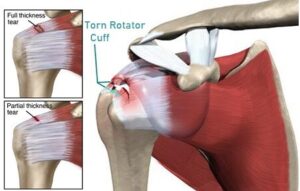
Rotator cuff injuries can significantly impact daily life and physical activities. Simple actions like getting dressed, reaching for items on high shelves, or participating in sports and recreational activities can become challenging or even impossible. Sleeping on the affected side may cause discomfort, and some individuals may experience difficulty with self-care activities like bathing or combing hair. The limitations imposed by these injuries can lead to frustration, decreased productivity, and reduced overall quality of life.
If you have been experiencing persistent shoulder pain, weakness, limited range of motion, or difficulty with everyday activities, it is highly recommended to consult a specialist who has the relevant medical knowledge and expertise. Dr Stuart Kirkham at the Sydney Orthopaedic Surgeon Clinic has been providing individualised and highly effective treatment options for rotator cuff injuries. His vast medical expertise, personalised advice, and tailored treatment plans can help deliver the best possible outcome and improve your quality of life. If you’re looking an expert rotator cuff repair in Sydney, don’t hesitate to get in touch with Dr Kirkham.
Diagnosis and Imaging of the Rotator Cuff
Diagnosing a rotator cuff injury involves a comprehensive evaluation that takes into account the patient’s symptoms, medical history, and physical examination. The process begins with a detailed discussion of the patient’s symptoms, including the duration, intensity, and any factors that aggravate or alleviate the pain. Dr Kirkham and his team at the Sydney Orthopaedic Surgeon Clinic are highly skilled in conducting these assessments to ensure an accurate diagnosis.
During the physical examination, Dr Kirkham will assess the patient’s range of motion of the shoulder joint, check for muscle strength and stability, and perform specific manoeuvres to elicit pain or reproduce symptoms. These tests help identify the specific structures involved and provide valuable information about the severity and location of the rotator cuff injury.
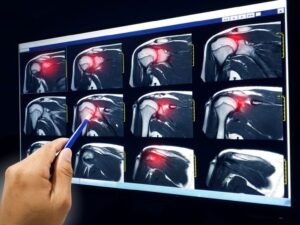
To confirm the diagnosis and further evaluate the rotator cuff, various imaging techniques may be used, and they include:
MRI Scans
MRI scans may be required to give Dr Kirkham a comprehensive view of the rotator cuff tendons, muscles, and other structures. This is important in helping to identify tears, inflammation, or any degenerative changes within the joint.
Ultrasound
Ultrasound scans allow for a dynamic evaluation of the rotator cuff to be conducted where the tendons and muscles will be assessed, and any fluid accumulation or abnormalities can be identified. These are particularly useful for detecting smaller tears or assessing the integrity of the tendons during movement.
X-Rays
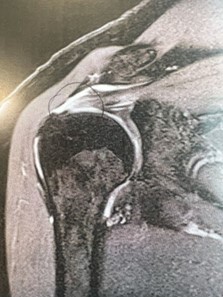
While X-rays do not directly visualise the rotator cuff, they are valuable in ruling out other conditions such as fractures, bone abnormalities, or joint degeneration. X-rays provide a clear view of the bones and joint spaces, and this is important in providing a comprehensive diagnosis to ensure no stone is left unturned.
By combining the information gathered from the patient’s history, physical examination, and imaging studies, Dr Kirkham can make an accurate diagnosis of the rotator cuff injury.
If you’re concerned that you may have been experiencing the symptoms of a rotator cuff injury, or if you have a family history of these conditions, it’s crucial to seek expert medical advice for a thorough diagnosis. Dr Stuart Kirkham and the team at the Sydney Orthopaedic Surgeon Clinic have extensive experience in diagnosing and treating rotator cuff injuries. By seeking their specialised care and advice, kickstarted by a thorough diagnosis that can set you on the road to recovery. Don’t hesitate to contact our friendly team to schedule a consultation to repair a torn rotator cuff in Sydney.
Treatment Options For Rotator Cuff Injuries
When it comes to treating rotator cuff injuries, Dr Kirkham and his team offer a range of effective treatment options tailored to each patient’s unique needs.
Non-surgical approaches are preferred and they are often the first line of treatment. These may include:
Physical Therapy
If the damage to the joint is not significant, a targeted exercise program designed by a skilled physical therapist can help improve shoulder strength, flexibility, and stability. Physical therapy aims to alleviate pain, restore range of motion, and enhance overall shoulder function.

Medications
Non-steroidal anti-inflammatory drugs (NSAIDs) may be prescribed to manage pain and reduce inflammation associated with rotator cuff injuries. These medications can help alleviate symptoms and improve comfort.
Injections
Corticosteroid injections into the shoulder joint can provide temporary relief by reducing inflammation and relieving pain. These injections may be used in conjunction with physical therapy to optimise results.
In cases where non-surgical treatments do not provide adequate relief or if the rotator cuff injury is severe, surgical intervention may be considered. Surgical procedures for rotator cuff injuries can range from minimally invasive arthroscopic techniques to more extensive open surgeries. The specific surgical approach will depend on factors such as the size, location, and severity of the rotator cuff tear.

Nevertheless, surgeons always differ in their techniques, and much of this is driven by preferences and the comfort of their training. Having worked with all the arthroscopic (keyhole) and open techniques available for over several decades, Dr Kirkham now uses a hybrid technique that combines arthroscopic surgery together with a small mini-open incision. This is preferable because it allows the surgery to be conducted more quickly and therefore less exposure to anaesthetics.
The anaesthetist may offer you a nerve block as well as a general anaesthetic (GA). The nerve block is typically performed under ultrasound control by your specialist anaesthetist just prior to your GA. The nerve block is to reduce not only postoperative pain but also to minimise intra-operative blood pressure. In essence, this means you’ll have exposure to fewer opiates, likely experience less nausea, and benefit from a shorter recovery time.
Dr Stuart Kirkham and the team of experts at the Sydney Orthopaedic Surgeon Clinic have been delivering highly effective and individualised treatment options for many years. From conservative non-surgical approaches to expertly conducted surgical procedures, Dr Kirkham will liaise with your physio and GP to coordinate a detailed tailored plan aiming to restore function as soon as possible and as fast as safely possible.
Prevention and Aftercare For Rotator Cuff Injuries
Preventing rotator cuff injuries is crucial for maintaining shoulder health. To reduce your risk of developing these injuries, there are a number of simple steps that you can take.
It’s important to maintain proper posture, avoiding slouching or rounded shoulders that can stress the rotator cuff. Regularly engaging in exercises that target the shoulder muscles, including the rotator cuff, can also provide better support and stability. Prior to physical activities or sports, warm-up exercises and stretching prepare the muscles and tendons. Using proper lifting techniques, such as lifting from the legs instead of relying solely on the arms and shoulders, is also essential. Taking regular breaks from occupations involving repetitive overhead motions allows the shoulder muscles to rest.
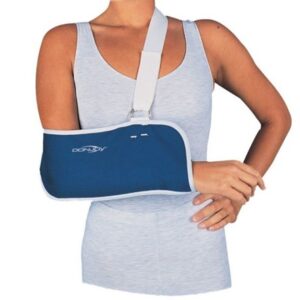
Aftercare is equally important in the recovery process. Following a tailored physical therapy program gradually strengthens the shoulder, improves the range of motion, and enhances function. Adhering to medication instructions, if prescribed, is crucial. Modifying activities to avoid straining the healing rotator cuff and gradually reintroducing them under guidance supports recovery. Maintaining a healthy lifestyle, including regular exercise, a balanced diet, and adequate sleep, promotes overall healing.
At the Sydney Orthopaedic Surgeon Clinic, we prioritise comprehensive care and provide guidance for effective prevention and successful recovery. Contact us to schedule a consultation with Dr Stuart Kirkham. With a comprehensive approach and personalised care, he can help you manage rotator cuff injuries, improve your shoulder function, and get back to the activities you love.
The Recovery Process for Rotator Cuff Injuries
The recovery process for rotator cuff injuries can vary depending on the severity of the injury and the chosen treatment approach. While every individual’s journey may differ, there are general milestones and expectations that can provide an overview of the recovery process.
In the initial stages, the focus is on pain management, reducing inflammation, and protecting the healing tissues. Patients are often advised to wear a sling or brace to immobilise the shoulder and allow for proper healing. During this phase, gentle range of motion exercises and physical therapy may be initiated under the guidance of a healthcare professional.
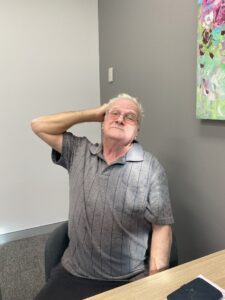
As the shoulder’s healing progresses, the emphasis shifts towards restoring strength, flexibility, and function. Physiotherapy plays a vital role in the recovery process by providing targeted exercises and therapies to gradually strengthen the rotator cuff muscles and improve the range of motion. These exercises may include stretching, resistance training, and functional movements designed to replicate activities of daily living or specific sport-related motions.
The duration of the recovery process can vary widely, ranging from several weeks to several months, depending on factors such as the extent of the injury, individual healing abilities, and adherence to the rehabilitation program. It is essential for patients to follow the guidance of their healthcare provider and engage actively in the prescribed exercises and therapies.
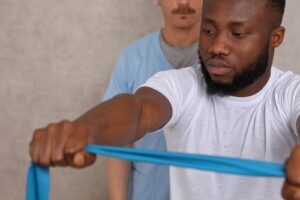
Regular monitoring and follow-up appointments are also important in monitoring progress and making any necessary adjustments to the treatment plan. Through a consistent commitment to rehabilitation, patients can gradually regain shoulder strength, stability, and function, enabling them to return to their normal activities and sports.
Dr Kirkham and his team at the Sydney Orthopaedic Surgeon Clinic understand the importance of a structured recovery process. When you rely on Dr Kirkham, you can expect to receive his expertise and valuable guidance and support throughout the journey, ensuring you receive all you need for a smooth recovery and return to an active and fulfilling lifestyle.
Possible Complications of Rotator Cuff Injuries
During the recovery process, it’s important to be aware of potential complications that can arise. These complications can vary in severity and may have an impact on the overall healing and rehabilitation process.
One potential complication is a delayed healing process. In some cases, the torn rotator cuff tendons may take longer than expected to heal properly, and this may be a result of factors such as the size and location of the tear, the patient’s overall health, and adherence to rehabilitation protocols. Dr Kirkham closely monitors the healing progress and may recommend adjustments to the treatment plan or additional interventions to promote optimal healing.
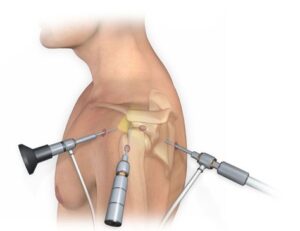
Infection is another potential complication, although it is relatively rare. Surgical procedures carry a small risk of infection, and prompt identification and treatment are essential in such cases. Dr Kirkham and his team follow strict sterilisation protocols and take necessary precautions to minimise the risk of infection. Should you suffer from an infection does occur, appropriate antibiotics or other interventions may be prescribed to address it effectively.
Rest assured that our dedicated team, led by Dr Kirkham, is here to provide compassionate support and effective treatment options tailored to your unique needs. Let us help you regain optimal shoulder function and get back to the activities you love. Contact us today to schedule a consultation and take your first step towards your recovery.
Are You Concerned About Rotator Cuff Injuries?
Rotator cuff tears can significantly impact your shoulder function and quality of life, but there are effective treatment options available to help you regain strength, reduce pain, and improve shoulder mobility. Non-surgical treatments, such as physical therapy, medications, and injections, can be effective for smaller tears or initial management. However, in more severe cases or for larger tears, surgical procedures may be necessary to repair the damaged tendon and restore shoulder function.
At the Sydney Orthopaedic Surgeon Clinic, we understand the impact that rotator cuff tears can have on your daily activities and overall well-being. Our team of healthcare professionals, led by Dr Stuart Kirkham, is dedicated to providing personalised, compassionate care to help you achieve optimal recovery and shoulder health. We offer a comprehensive range of treatment options for rotator cuff tears, tailored to your specific needs and goals.

If you are experiencing symptoms of a rotator cuff tear, it is important to seek medical attention promptly. Dr Stuart Kirkham can provide an accurate evaluation and recommend the most appropriate treatment approach for your condition. With his expertise and commitment to individualised care, he will work closely with you to develop a treatment plan that addresses your unique needs and helps you on the path to recovery.
Contact the Sydney Orthopaedic Surgeon Clinic today to schedule a consultation and take the first step towards finding relief from your symptoms and achieving optimal shoulder health. Our team is here to support you throughout your journey to recovery.
Frequently Asked Questions
1. Can rotator cuff injuries heal on their own without treatment?
Rotator cuff injuries may not always heal on their own, especially larger or more severe tears. Smaller tears or strains may have a chance of healing with conservative measures like rest, ice, and physical therapy. However, it is important to seek medical evaluation for an accurate diagnosis and appropriate treatment to optimise healing and prevent further complications.
2. Can rotator cuff injuries be prevented?
While it is not always possible to prevent rotator cuff injuries, certain measures can reduce the risk. Maintaining proper posture, avoiding repetitive overhead motions, and practicing safe lifting techniques can help. Regularly engaging in shoulder-strengthening exercises, maintaining overall fitness, and listening to your body’s limits during physical activities can also contribute to injury prevention.
3. How long does the recovery process take after rotator cuff surgery?
The recovery process after rotator cuff surgery can vary depending on several factors, including the extent of the injury, the surgical technique used, and individual healing abilities. Generally, it may take several months for the shoulder to fully recover and regain strength and function. Physical therapy and rehabilitation are essential components of the recovery process and can help expedite healing and restore range of motion. If you’re looking for an experienced orthopaedic surgeon to deliver a rotator cuff repair in Sydney, don’t hesitate to get in touch with Dr Kirkham.
4. Can physical therapy alone heal a rotator cuff tear?
Physical therapy can be beneficial in the management of rotator cuff tears, especially in cases of partial tears or smaller injuries. Physical therapy helps to strengthen the surrounding muscles, improve shoulder stability, and enhance range of motion. However, larger or more significant tears may require surgical intervention to repair the tendon and achieve optimal outcomes.
5. Can corticosteroid injections permanently cure rotator cuff injuries?
Corticosteroid injections can provide temporary relief by reducing inflammation and alleviating pain associated with rotator cuff injuries. However, they do not address the underlying cause or repair the damaged tendon. Their effects are temporary, and multiple injections may be necessary over time. For more significant or persistent rotator cuff injuries, surgical intervention may be required for a long-term resolution.
References
- Mayo Clinic (Rotator Cuff Injury)
- Ortho Info (Rotator Cuff Tears)
- Cleveland Clinic (Rotator Cuff Tears)
- Health Direct (Rotator Cuff Injuries)


